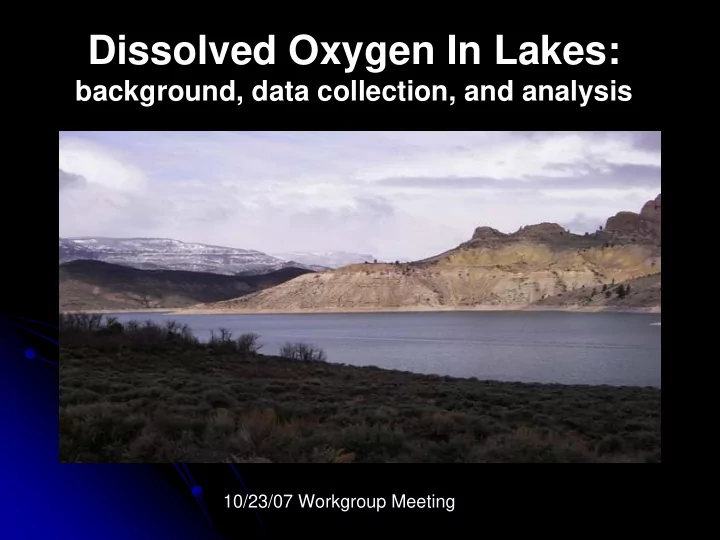

Dissolved Oxygen In Lakes: background, data collection, and analysis 10/23/07 Workgroup Meeting
31.16 Table 1. Footnote #9 ‘The dissolved oxygen criteria is intended to apply to ‘The dissolved oxygen criteria is intended to apply to the epilimnion and metalimnion strata of lakes and the epilimnion and metalimnion strata of lakes and reservoirs. Dissolved oxygen in the hypolimnion may, reservoirs. Dissolved oxygen in the hypolimnion may, due to the natural conditions, be less than the table due to the natural conditions, be less than the table criteria. No reductions in dissolved oxygen levels due criteria. No reductions in dissolved oxygen levels due to controllable sources is allowed.’ to controllable sources is allowed.’ Questions about the interpretation of this footnote arose during temperature criteria development and during discussions of 303(d) listing methodology.
‘Adequate Refuge’ Concept for Temperature Criteria in Lakes Adequate refuge depends on concurrent Adequate refuge depends on concurrent attainment of applicable dissolved oxygen attainment of applicable dissolved oxygen standards. (31.16 standards. (31.16, Table 1, footnote c, iii) , Table 1, footnote c, iii)
Spring Turnover Lake water is uniform in temperature and oxygen. When wind blows, lake mixes from top to bottom. Wind gases
Summer Stratification Sun and warm air heat the top layer of the lake. Epilimnion is warm and water is less dense. Metalimnion is characterized by rapid temperature change called the thermocline. Hypolimnion is cool and water is more dense. Epilimnion Metalimnion Hypolimnion
Summer Stratification When wind blows, only epilimnion mixes, and exchanges gases with atmosphere. Waters of epilimnion resist mixing with cooler water due to the density gradient. Wind gases Epilimnion Metalimnion Hypolimnion
Summer Stratification Plankton and other organic material fall to the bottom. Decomposers consume the organic material and oxygen. Oxygen decreases in the hypolimnion throughout the summer. Diffusion is not efficient enough to re-supply oxygen in the hypolimnion. gases Plankton/organic matter Epilimnion Metalimnion Hypolimnion CO 2 O 2 Decomposers
Data Collection � Temperature profiles Temperature profiles � � D.O. profiles D.O. profiles � � pH profiles pH profiles � α Chlorophyll α � Chlorophyll � � Nutrient data (especially total P) Nutrient data (especially total P) � Data will be used to create two databases, one for warm lakes/res, and one for cold. The warmwater database will be completed first.
Sites Collected Kenney � � Kenney Adobe Creek � � Adobe Creek � Loveland Loveland � Arvada � Arvada � Lonetree � � Lonetree Aurora � � Aurora Meredith � � Meredith � Barr Barr � Milton � Milton � Boulder � Boulder � Narraguinnep � � Narraguinnep Boyd � � Boyd � Neegronda Neegronda � � Carter Carter � North Sterling � North Sterling � Cherry Creek � � Cherry Creek Prewitt � � Prewitt Fruitgrowers � � Fruitgrowers � Prospect Prospect � Henry � Henry � Puett � � Puett Highline � � Highline Quincy � � Quincy � Horse Creek Horse Creek � Rio Blanco � Rio Blanco � Horseshoe � Horseshoe � Standley � � Standley Jackson � � Jackson � Sweitzer Sweitzer � � John Martin John Martin � Totten � Totten � Jumbo � � Jumbo Union � � Union
Warmwater Database � Available in early 2008 Available in early 2008 � � Look for relationships between oxygen Look for relationships between oxygen � depletion, chlorophyll concentrations, nutrients, depletion, chlorophyll concentrations, nutrients, and fishery health. and fishery health. � Investigate natural variability in Investigate natural variability in hypolimnetic hypolimnetic � D.O. D.O.
Recommend
More recommend